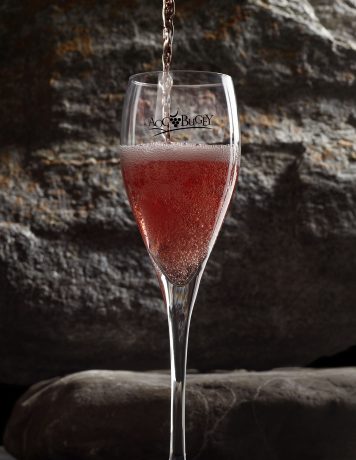Discover
the Bugey Vineyard
Discover the Bugey vineyard which covers an area of 500 hectares divided up into three geographical areas – Cerdon, Montagnieu, Belley – and boasts some 80 passionate winegrowers, all with exceptional skills and producing high-quality, mainly sparkling wines.
This knowledge and expertise form part of a comprehensive set of very precise methods including the balance of grape varieties, production times, the specific type of maceration used, the choice between ageing in barrels or vats, and the traditional or ancestral method used for sparkling wines. It is this array of techniques that contributes to the exceptional authenticity and distinctive character of Bugey AOC and Roussette du Bugey AOC. To ensure adherence to these very high standards, both appellations are governed by strict production regulations outlined in two specifications, each of which is subject to inspection procedures.
Wines must be manufactured within a specific geographical area, reflecting a terroir. Bugey AOC wines offer a diverse range of still white, red, and rosé wines, as well as sparkling wines, showcasing the abundance and uniqueness of this terroir. All of them will intrigue and delight wine enthusiasts, experts, and epicureans seeking sensory experiences. Renowned for its commitment to preserving rare native grape varieties, the Bugey AOC appellation strives to defend and showcase wines that have strong ties to their terroir. Bugey AOC, one of the most recent appellations, boasts an outstanding dynamism which has enabled it to achieve this prestigious recognition, and motivates its dedicated winegrowers and producers on a daily basis, all passionate about sharing their love for the region and its wines.
Bugey AOC wines in figures
The Bugey AOC vineyard is made up of three distinct terroirs with some 80 winegrowers and 55 grape growers.
The terroir features 9 appellations: Bugey White AOC, Roussette du Bugey AOC, Bugey Rosé AOC, Bugey Gamay AOC, Bugey Pinot Noir AOC, Bugey Mondeuse AOC, Traditional Method Brut Bugey AOC and Bugey Cerdon AOC, available in 8 categories of wine. 40% of the surface area is organically farmed and 36% of the surface area has HEV certification.
60% of the wines produced are sparkling wines – the speciality of the Bugey vineyard. Still wines are divided up into three colours: 57% white wines, 35% red wines and 8% rosé wines. The average production is of 24,000 hectolitres for some 4 million bottles sold.

Bugey AOC wines, the appellation d’origine contrôlée in figures









The history of the Bugey vineyard
The wine industry was at its peak in about 1870. At the time, according to certain sources, the Ain region boasted an impressive 20,000 hectares of vineyards, including 7,000 in Bugey. However, the devastating invasion of phylloxera, an aphid originating from the United States, put an end to this prosperity. The vineyards were severely impacted and a prolonged decline followed that lasted several decades.
In about 1950, Colonel François Brillat-Savarin was surprised by the absence of an appellation for the wines produced in the region. This marked a change of approach. A group of influential figures from Bugey took the initiative to establish a syndicate of winegrowers. It was created on the 4 April 1955 with the aim of obtaining the appellation d’origine.
In July 1955, the Fédération des V.D.Q.S. (delimited wine of superior quality) agreed to the listing of Bugey. Hope was thus reborn.
However, there was still a great deal of work to be done due to the numerous municipalities and the diversity of terroirs, altitudes and exposures.
The initial V.D.Q.S. classification was officially published in July 1958,
and prompted some farmers to specialise in winegrowing instead of their previous mixed farming activities.
Without the creation of the syndicate and the subsequent appellation, vines probably would have disappeared from Bugey. The classification paved the way for the vineyard’s gradual reconstitution. The process required time as the appellation covers a vast area, with 58 municipalities in the original decree of 1963, then 65. Moreover, as the map shows, this is a vineyard of small islands. At the same time, the grape varieties used were being simplified. In 1920, the renowned gastronome Curnonsky celebrated the exceptional cuisine of Bresse and Bugey.
There was an abundance of grape varieties, with many hybrids.
The challenging sales situation prompted influential figures in the wine industry to consider a new direction for the vineyard. Wine competitions had shown that exceptional vintages were produced in areas that gave priority to good grape varieties.
In 1972, the Bugey winegrowers submitted an initial application for an AOC. Unfortunately, it was unsuccessful: deemed to be premature. However, everyone has to start somewhere!
Throughout this period, vineyards became increasingly specialised, with replanting and the elimination of certain grape varieties, particularly hybrids. Once these vines started to produce, farmers ceased milk production which had become incompatible with their work in the vineyards, wineries, and wine sales. They instead invested in vats, storage facilities, and modern wine-making equipment.
A second application for an AOC was submitted in 1987, accompanied by a comprehensive dossier. In 1994, a committee of experts visited the site to assess the strengths and weaknesses of Bugey wines. Unfortunately, the great variety of vines and wines posed an obstacle to the AOC.
The INAO’s requirement for red wines included a blend of red grape varieties,
but the syndicate was opposed to such simplification. Over the years, the surface area and volumes continued to rise: 5,845 hl in 1973, 29,008 hl in 2000
By the beginning of 2002, the situation appeared to be at a standstill. However, gradual progress was made on the specifications.
The committee in charge of the “accession enquiry” came back in July 2008 and made a number of recommendations which were taken into account. Consequently, the INAO finally gave the Bugey AOC the green light on 28 May 2009. At the same time, the Syndicate of Bugey Wines was recognised as an “Organisme de Défense et de Gestion”.
Since 2009, following approval by a tasting panel, Bugey AOC has been awarded to still white, red and rosé wines, as well as fully sparkling and semi-sparkling white and rosé wines.
Fine and Marc represent a production that is much more limited but deeply steeped in the region’s traditions, with the passage of the mobile still through the villages and hamlets being a key moment in the life of the inhabitants. A distinction has to be made between Bugey wine brandy, or Fine, which is distilled from wine, and Marc, which is made from the marc, i.e., the grapes after they have been pressed. These two PGIs were recognised in January 2015.


